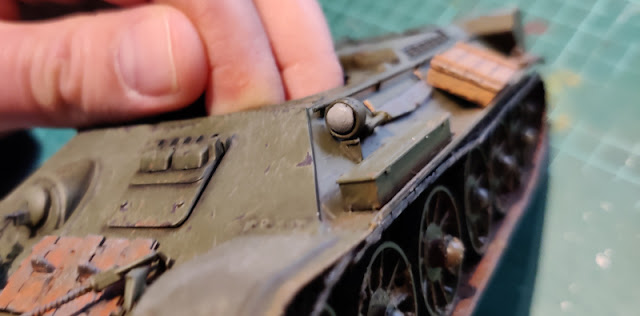Now it was the time to decide if my painting order was good or useless. So far I had left these funky effects last, and hadn't had to suffer from it, so I was confident.
Viewports
Maybe someone who read the post from two weeks ago noticed that I had been looking at the colour wheel, and even read a tiny bit amount of text about the theory behind all that. Not that I was trying to be artistic or to follow a certain direction, this was just out of curiosity and also to find out useful colours.
So, I had looked at the colour wheel with the idea of finding the viewport colour that would stand out nicely but not stupidly from the yellow/green pattern. On the opposing side of yellow and green was some violet/lilac, but that would've required some colour mixing again and I didn't just feel like it. The PPC blue was close enough on the arc (and if I wanted to force it towards red, I could always apply a Druchii Violet wash unless it had followed the Citadel's paint and pot quality of this millennium and dried up completely).
Because there were so many of these tiny vision slits, I didn't stop to take photos between each blue layer. They were also annoyingly narrow, so making the effect was a bit far-fetched with my skills. In this fantastic triptych above we had a four layer effect: bottommost layer was plain blue (VGC 72023 Electric Blue), then the next layers were aligned top-left with a constantly increasing padding with a paint with a bit more white (VMA 71279 RAL9001 White) mixed in. For this photoset I hadn't yet added the whiteish dot per viewport, as I didn't trust my eyes not being crossed after a surprisingly long stint.
Small Laser and the targeting beamer
The next step was much more pleasant, there was nothing to think about with the Small Laser's lens colour as I had decided my energy weapon colours and was sticking to them. The bigger problem now was, just like earlier. what was I going to do with the lenses that were not weapons? So far I had used the same or lighter reds than with Small Lasers, but for consistency a specific "not a shooter" lens colour would be better. I was thinking of a yellow-orange or violet, but didn't really have a strong gut feeling about any of this.
Nothing sounded like a clear, immediate solution, so I went with a red lens for the not-laser gun as well. The method was exactly the same as before: a red base (VGA 72710 Bloody Red), then a bottom-right -positioned lighter (again toned up with RAL9001) paint, and while I had the space I made another brighter layer and painted in the top left sector of the previous one, as far as I could control my paints in these tiny spaces. As the sugar in my cappucino I also added the whiteish dots to the top left area. From this viewpoint the lasers looked pretty good, even if I said so myself.
Looking at that photo I felt that I had to paint the cannon's bottom black again. Dark grey worked fantastically everywhere else, but it just looked a bit funky when staring straight down the barrel.
I wasn't overflowing with joy with the glowiness of the viewports, but they were tight and that made them damn difficult for my skills. Maybe adding the glow dot would help, I just wasn't sure if I dared to try in the tiny square ones, or would I just fill them with white...
Well, I did dare and while I was at it, I also blackened the bottom of the Autocannon's barrel. Now it was good enough for me.


























































